Analysis of External Business Environment and Strategic Decisions
VerifiedAdded on 2021/06/15
|7
|1334
|26
Report
AI Summary
This report provides an in-depth analysis of the external business environment, exploring its influence on organizational performance and strategic decision-making. It examines the political, economic, social, and technological factors that impact businesses, offering a comprehensive overview of how these elements shape market competitiveness. The report further delves into the challenges and opportunities presented by the external environment, utilizing frameworks and tools to assess these influences. A significant portion of the report is dedicated to a case study on Kodak, analyzing the company's failure to adapt to changes in the digital environment. The analysis highlights the crucial role of understanding and responding to external factors for sustained business success, emphasizing the need for adaptability and strategic foresight in a dynamic market.
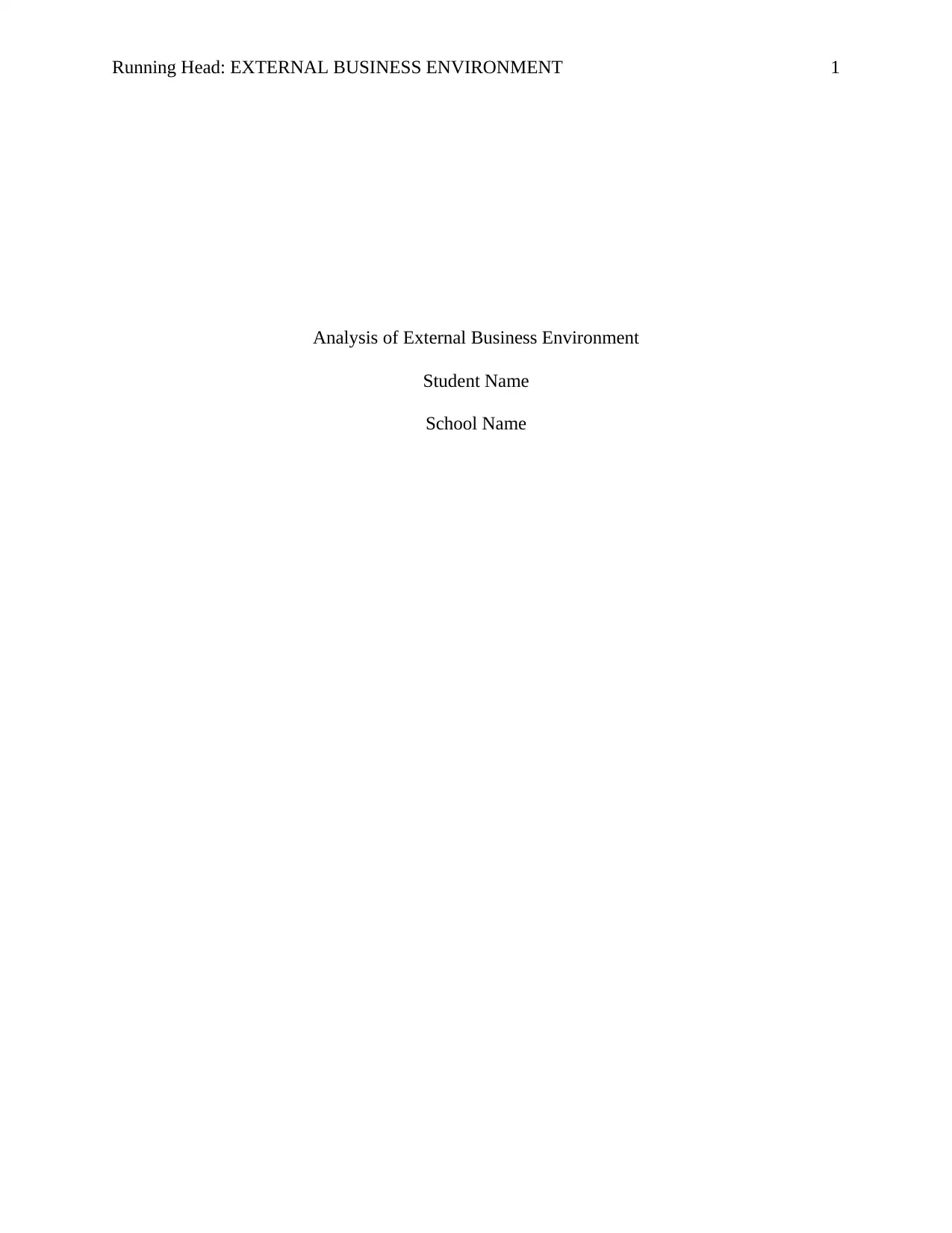
Running Head: EXTERNAL BUSINESS ENVIRONMENT 1
Analysis of External Business Environment
Student Name
School Name
Analysis of External Business Environment
Student Name
School Name
Paraphrase This Document
Need a fresh take? Get an instant paraphrase of this document with our AI Paraphraser
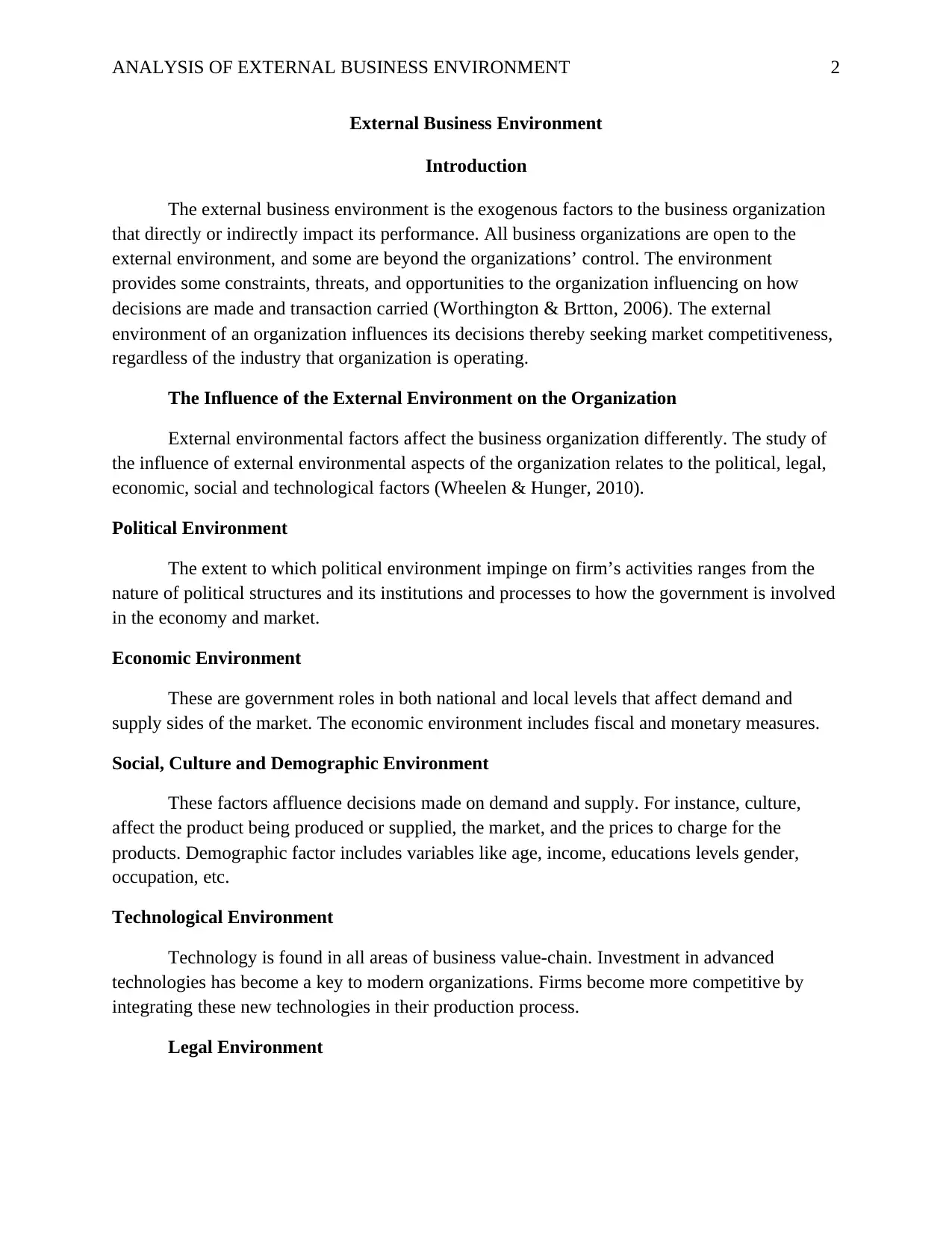
ANALYSIS OF EXTERNAL BUSINESS ENVIRONMENT 2
External Business Environment
Introduction
The external business environment is the exogenous factors to the business organization
that directly or indirectly impact its performance. All business organizations are open to the
external environment, and some are beyond the organizations’ control. The environment
provides some constraints, threats, and opportunities to the organization influencing on how
decisions are made and transaction carried (Worthington & Brtton, 2006). The external
environment of an organization influences its decisions thereby seeking market competitiveness,
regardless of the industry that organization is operating.
The Influence of the External Environment on the Organization
External environmental factors affect the business organization differently. The study of
the influence of external environmental aspects of the organization relates to the political, legal,
economic, social and technological factors (Wheelen & Hunger, 2010).
Political Environment
The extent to which political environment impinge on firm’s activities ranges from the
nature of political structures and its institutions and processes to how the government is involved
in the economy and market.
Economic Environment
These are government roles in both national and local levels that affect demand and
supply sides of the market. The economic environment includes fiscal and monetary measures.
Social, Culture and Demographic Environment
These factors affluence decisions made on demand and supply. For instance, culture,
affect the product being produced or supplied, the market, and the prices to charge for the
products. Demographic factor includes variables like age, income, educations levels gender,
occupation, etc.
Technological Environment
Technology is found in all areas of business value-chain. Investment in advanced
technologies has become a key to modern organizations. Firms become more competitive by
integrating these new technologies in their production process.
Legal Environment
External Business Environment
Introduction
The external business environment is the exogenous factors to the business organization
that directly or indirectly impact its performance. All business organizations are open to the
external environment, and some are beyond the organizations’ control. The environment
provides some constraints, threats, and opportunities to the organization influencing on how
decisions are made and transaction carried (Worthington & Brtton, 2006). The external
environment of an organization influences its decisions thereby seeking market competitiveness,
regardless of the industry that organization is operating.
The Influence of the External Environment on the Organization
External environmental factors affect the business organization differently. The study of
the influence of external environmental aspects of the organization relates to the political, legal,
economic, social and technological factors (Wheelen & Hunger, 2010).
Political Environment
The extent to which political environment impinge on firm’s activities ranges from the
nature of political structures and its institutions and processes to how the government is involved
in the economy and market.
Economic Environment
These are government roles in both national and local levels that affect demand and
supply sides of the market. The economic environment includes fiscal and monetary measures.
Social, Culture and Demographic Environment
These factors affluence decisions made on demand and supply. For instance, culture,
affect the product being produced or supplied, the market, and the prices to charge for the
products. Demographic factor includes variables like age, income, educations levels gender,
occupation, etc.
Technological Environment
Technology is found in all areas of business value-chain. Investment in advanced
technologies has become a key to modern organizations. Firms become more competitive by
integrating these new technologies in their production process.
Legal Environment
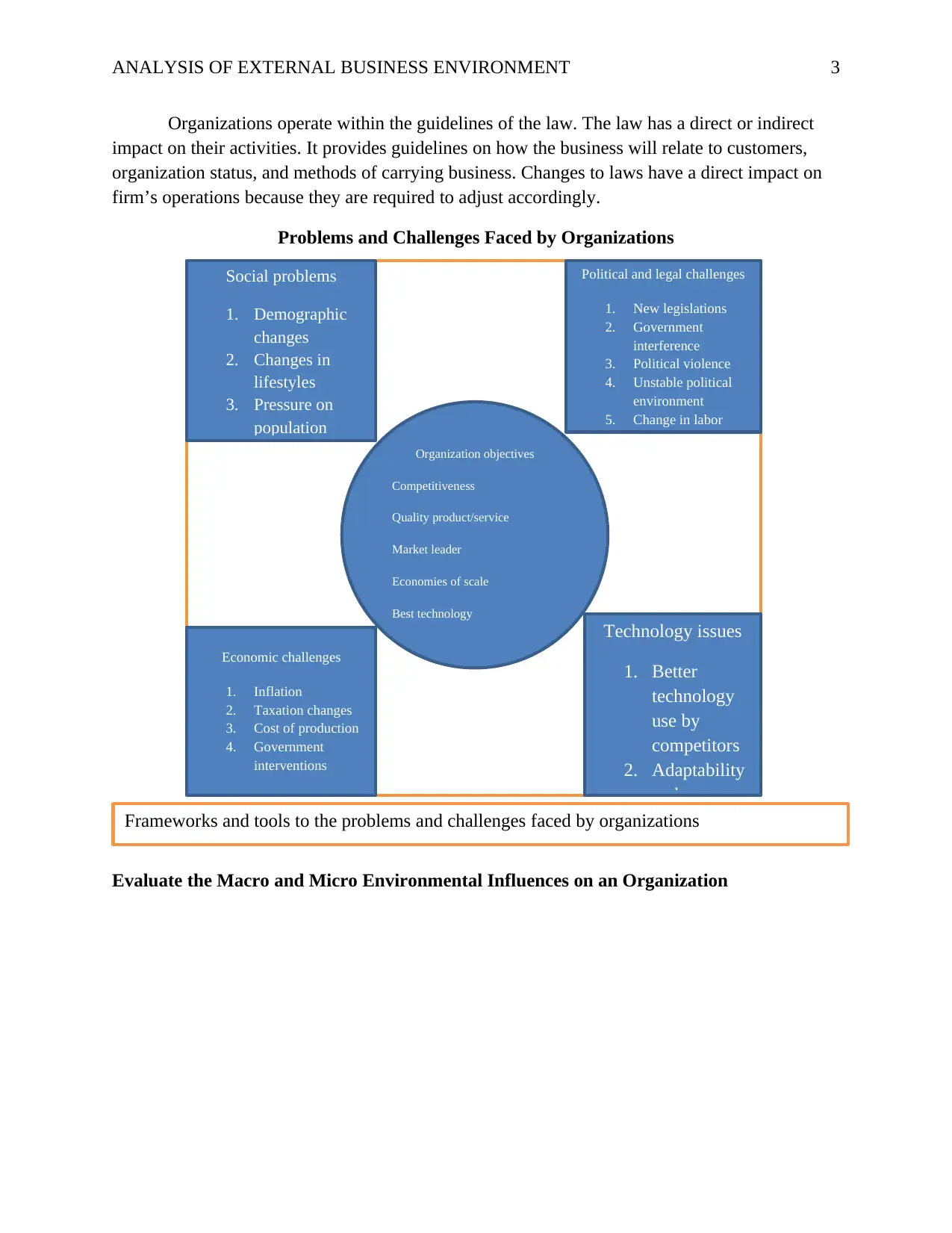
ANALYSIS OF EXTERNAL BUSINESS ENVIRONMENT 3
Organizations operate within the guidelines of the law. The law has a direct or indirect
impact on their activities. It provides guidelines on how the business will relate to customers,
organization status, and methods of carrying business. Changes to laws have a direct impact on
firm’s operations because they are required to adjust accordingly.
Problems and Challenges Faced by Organizations
Evaluate the Macro and Micro Environmental Influences on an Organization
ss
Organization objectives
Competitiveness
Quality product/service
Market leader
Economies of scale
Best technology
Social problems
1. Demographic
changes
2. Changes in
lifestyles
3. Pressure on
population
Political and legal challenges
1. New legislations
2. Government
interference
3. Political violence
4. Unstable political
environment
5. Change in labor
Economic challenges
1. Inflation
2. Taxation changes
3. Cost of production
4. Government
interventions
Technology issues
1. Better
technology
use by
competitors
2. Adaptability
and
Frameworks and tools to the problems and challenges faced by organizations
Organizations operate within the guidelines of the law. The law has a direct or indirect
impact on their activities. It provides guidelines on how the business will relate to customers,
organization status, and methods of carrying business. Changes to laws have a direct impact on
firm’s operations because they are required to adjust accordingly.
Problems and Challenges Faced by Organizations
Evaluate the Macro and Micro Environmental Influences on an Organization
ss
Organization objectives
Competitiveness
Quality product/service
Market leader
Economies of scale
Best technology
Social problems
1. Demographic
changes
2. Changes in
lifestyles
3. Pressure on
population
Political and legal challenges
1. New legislations
2. Government
interference
3. Political violence
4. Unstable political
environment
5. Change in labor
Economic challenges
1. Inflation
2. Taxation changes
3. Cost of production
4. Government
interventions
Technology issues
1. Better
technology
use by
competitors
2. Adaptability
and
Frameworks and tools to the problems and challenges faced by organizations
⊘ This is a preview!⊘
Do you want full access?
Subscribe today to unlock all pages.

Trusted by 1+ million students worldwide
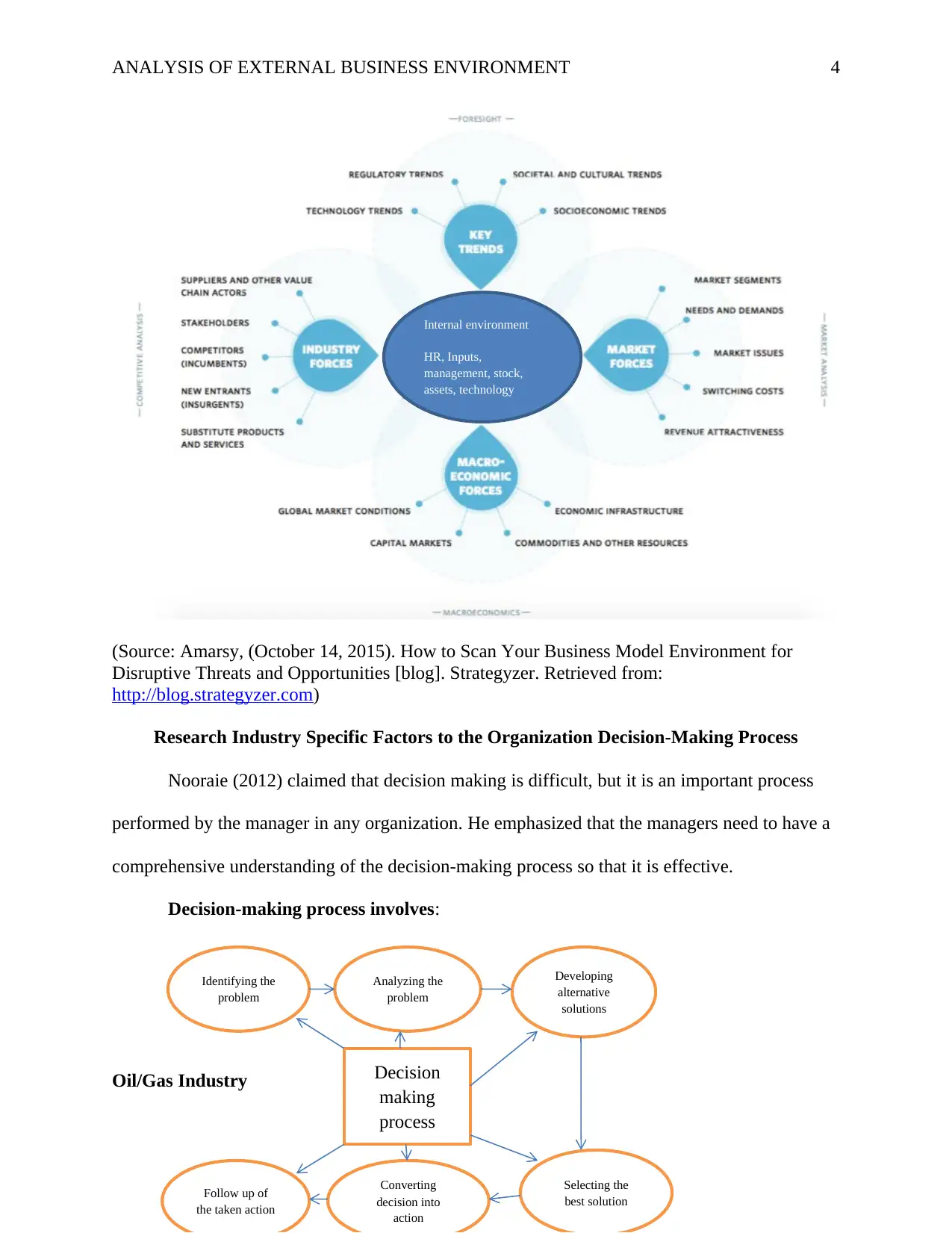
ANALYSIS OF EXTERNAL BUSINESS ENVIRONMENT 4
(Source: Amarsy, (October 14, 2015). How to Scan Your Business Model Environment for
Disruptive Threats and Opportunities [blog]. Strategyzer. Retrieved from:
http://blog.strategyzer.com)
Research Industry Specific Factors to the Organization Decision-Making Process
Nooraie (2012) claimed that decision making is difficult, but it is an important process
performed by the manager in any organization. He emphasized that the managers need to have a
comprehensive understanding of the decision-making process so that it is effective.
Decision-making process involves:
Oil/Gas Industry
Internal environment
HR, Inputs,
management, stock,
assets, technology
Decision
making
process
Identifying the
problem
Analyzing the
problem
Developing
alternative
solutions
Follow up of
the taken action
Converting
decision into
action
Selecting the
best solution
(Source: Amarsy, (October 14, 2015). How to Scan Your Business Model Environment for
Disruptive Threats and Opportunities [blog]. Strategyzer. Retrieved from:
http://blog.strategyzer.com)
Research Industry Specific Factors to the Organization Decision-Making Process
Nooraie (2012) claimed that decision making is difficult, but it is an important process
performed by the manager in any organization. He emphasized that the managers need to have a
comprehensive understanding of the decision-making process so that it is effective.
Decision-making process involves:
Oil/Gas Industry
Internal environment
HR, Inputs,
management, stock,
assets, technology
Decision
making
process
Identifying the
problem
Analyzing the
problem
Developing
alternative
solutions
Follow up of
the taken action
Converting
decision into
action
Selecting the
best solution
Paraphrase This Document
Need a fresh take? Get an instant paraphrase of this document with our AI Paraphraser
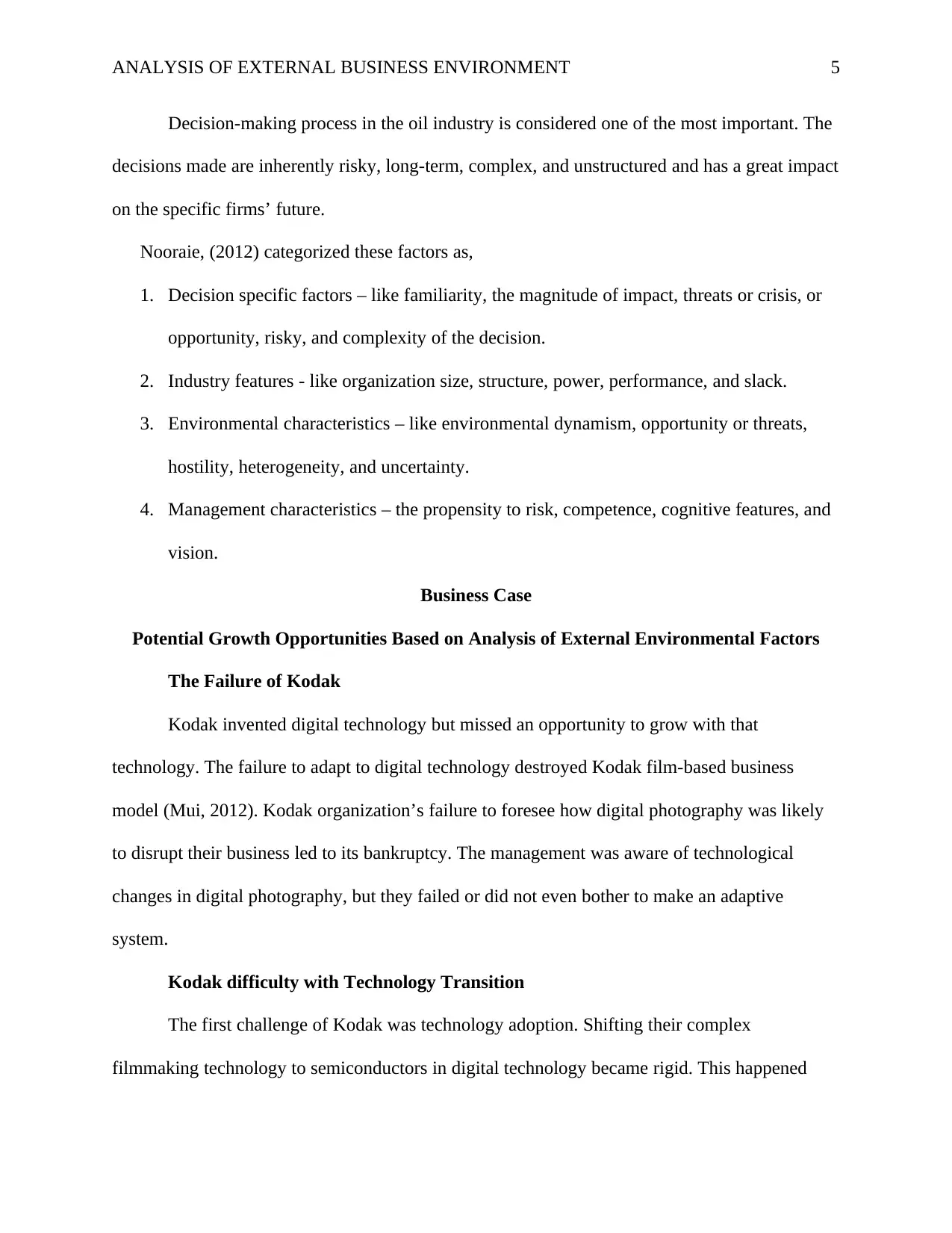
ANALYSIS OF EXTERNAL BUSINESS ENVIRONMENT 5
Decision-making process in the oil industry is considered one of the most important. The
decisions made are inherently risky, long-term, complex, and unstructured and has a great impact
on the specific firms’ future.
Nooraie, (2012) categorized these factors as,
1. Decision specific factors – like familiarity, the magnitude of impact, threats or crisis, or
opportunity, risky, and complexity of the decision.
2. Industry features - like organization size, structure, power, performance, and slack.
3. Environmental characteristics – like environmental dynamism, opportunity or threats,
hostility, heterogeneity, and uncertainty.
4. Management characteristics – the propensity to risk, competence, cognitive features, and
vision.
Business Case
Potential Growth Opportunities Based on Analysis of External Environmental Factors
The Failure of Kodak
Kodak invented digital technology but missed an opportunity to grow with that
technology. The failure to adapt to digital technology destroyed Kodak film-based business
model (Mui, 2012). Kodak organization’s failure to foresee how digital photography was likely
to disrupt their business led to its bankruptcy. The management was aware of technological
changes in digital photography, but they failed or did not even bother to make an adaptive
system.
Kodak difficulty with Technology Transition
The first challenge of Kodak was technology adoption. Shifting their complex
filmmaking technology to semiconductors in digital technology became rigid. This happened
Decision-making process in the oil industry is considered one of the most important. The
decisions made are inherently risky, long-term, complex, and unstructured and has a great impact
on the specific firms’ future.
Nooraie, (2012) categorized these factors as,
1. Decision specific factors – like familiarity, the magnitude of impact, threats or crisis, or
opportunity, risky, and complexity of the decision.
2. Industry features - like organization size, structure, power, performance, and slack.
3. Environmental characteristics – like environmental dynamism, opportunity or threats,
hostility, heterogeneity, and uncertainty.
4. Management characteristics – the propensity to risk, competence, cognitive features, and
vision.
Business Case
Potential Growth Opportunities Based on Analysis of External Environmental Factors
The Failure of Kodak
Kodak invented digital technology but missed an opportunity to grow with that
technology. The failure to adapt to digital technology destroyed Kodak film-based business
model (Mui, 2012). Kodak organization’s failure to foresee how digital photography was likely
to disrupt their business led to its bankruptcy. The management was aware of technological
changes in digital photography, but they failed or did not even bother to make an adaptive
system.
Kodak difficulty with Technology Transition
The first challenge of Kodak was technology adoption. Shifting their complex
filmmaking technology to semiconductors in digital technology became rigid. This happened
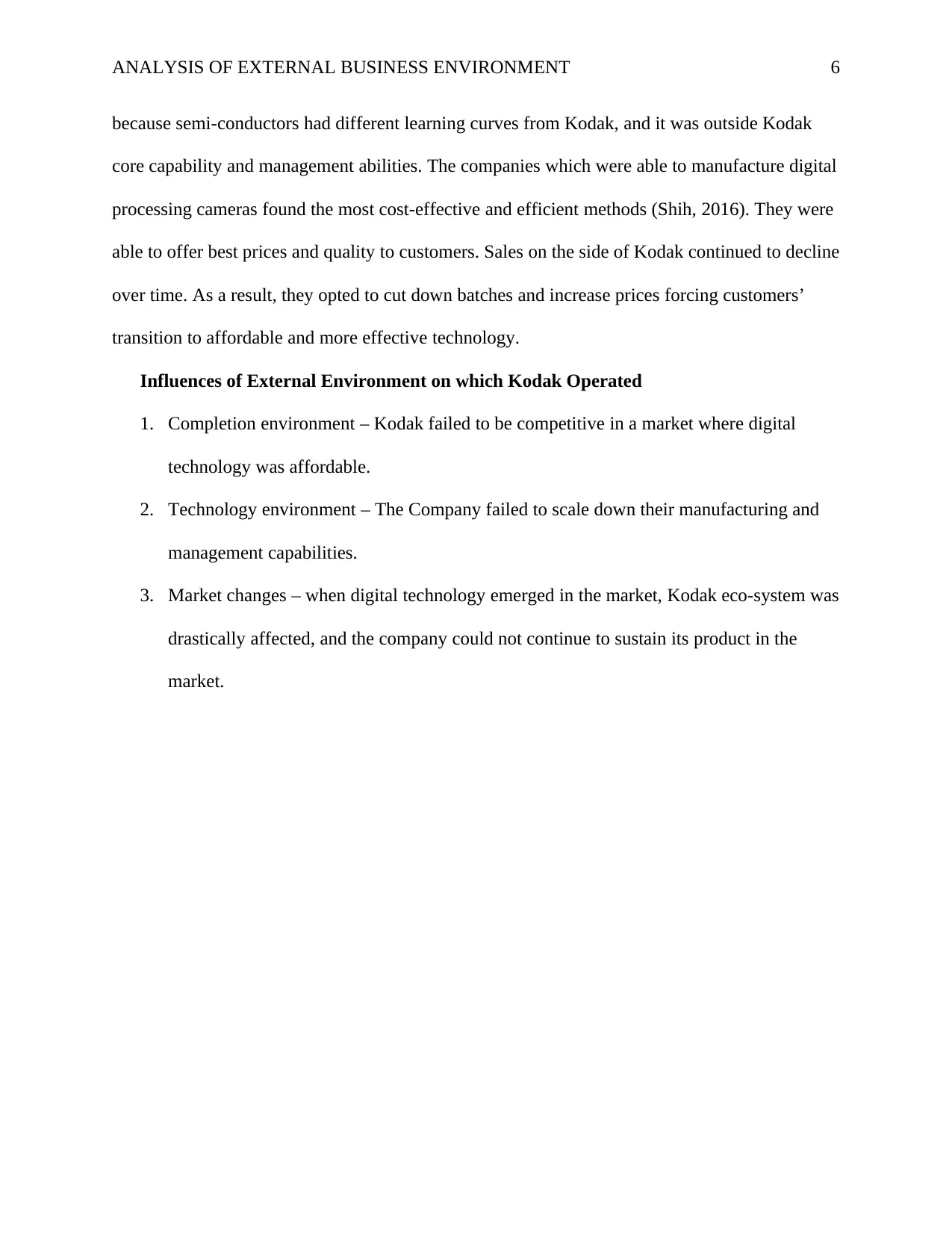
ANALYSIS OF EXTERNAL BUSINESS ENVIRONMENT 6
because semi-conductors had different learning curves from Kodak, and it was outside Kodak
core capability and management abilities. The companies which were able to manufacture digital
processing cameras found the most cost-effective and efficient methods (Shih, 2016). They were
able to offer best prices and quality to customers. Sales on the side of Kodak continued to decline
over time. As a result, they opted to cut down batches and increase prices forcing customers’
transition to affordable and more effective technology.
Influences of External Environment on which Kodak Operated
1. Completion environment – Kodak failed to be competitive in a market where digital
technology was affordable.
2. Technology environment – The Company failed to scale down their manufacturing and
management capabilities.
3. Market changes – when digital technology emerged in the market, Kodak eco-system was
drastically affected, and the company could not continue to sustain its product in the
market.
because semi-conductors had different learning curves from Kodak, and it was outside Kodak
core capability and management abilities. The companies which were able to manufacture digital
processing cameras found the most cost-effective and efficient methods (Shih, 2016). They were
able to offer best prices and quality to customers. Sales on the side of Kodak continued to decline
over time. As a result, they opted to cut down batches and increase prices forcing customers’
transition to affordable and more effective technology.
Influences of External Environment on which Kodak Operated
1. Completion environment – Kodak failed to be competitive in a market where digital
technology was affordable.
2. Technology environment – The Company failed to scale down their manufacturing and
management capabilities.
3. Market changes – when digital technology emerged in the market, Kodak eco-system was
drastically affected, and the company could not continue to sustain its product in the
market.
⊘ This is a preview!⊘
Do you want full access?
Subscribe today to unlock all pages.

Trusted by 1+ million students worldwide
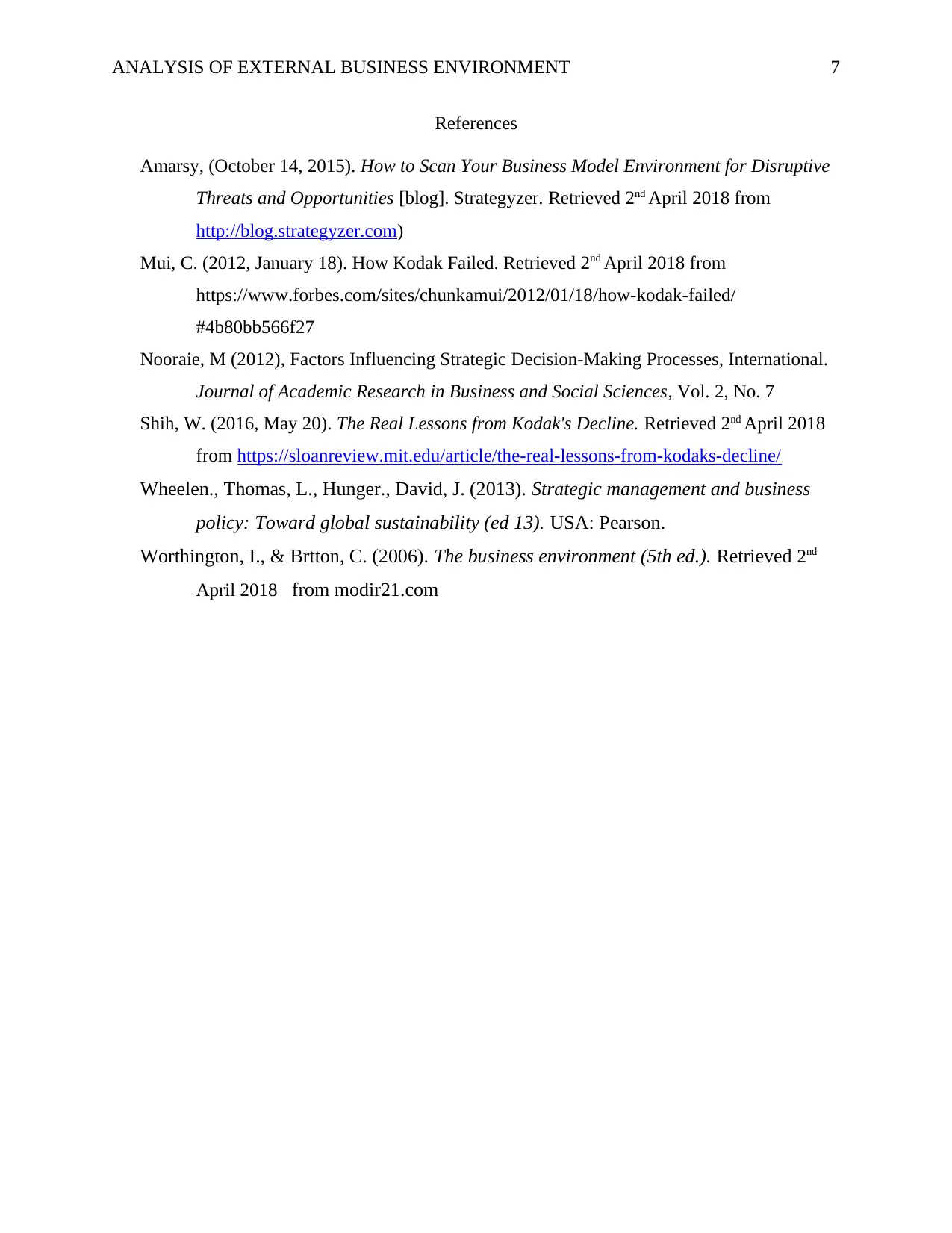
ANALYSIS OF EXTERNAL BUSINESS ENVIRONMENT 7
References
Amarsy, (October 14, 2015). How to Scan Your Business Model Environment for Disruptive
Threats and Opportunities [blog]. Strategyzer. Retrieved 2nd April 2018 from
http://blog.strategyzer.com)
Mui, C. (2012, January 18). How Kodak Failed. Retrieved 2nd April 2018 from
https://www.forbes.com/sites/chunkamui/2012/01/18/how-kodak-failed/
#4b80bb566f27
Nooraie, M (2012), Factors Influencing Strategic Decision-Making Processes, International.
Journal of Academic Research in Business and Social Sciences, Vol. 2, No. 7
Shih, W. (2016, May 20). The Real Lessons from Kodak's Decline. Retrieved 2nd April 2018
from https://sloanreview.mit.edu/article/the-real-lessons-from-kodaks-decline/
Wheelen., Thomas, L., Hunger., David, J. (2013). Strategic management and business
policy: Toward global sustainability (ed 13). USA: Pearson.
Worthington, I., & Brtton, C. (2006). The business environment (5th ed.). Retrieved 2nd
April 2018 from modir21.com
References
Amarsy, (October 14, 2015). How to Scan Your Business Model Environment for Disruptive
Threats and Opportunities [blog]. Strategyzer. Retrieved 2nd April 2018 from
http://blog.strategyzer.com)
Mui, C. (2012, January 18). How Kodak Failed. Retrieved 2nd April 2018 from
https://www.forbes.com/sites/chunkamui/2012/01/18/how-kodak-failed/
#4b80bb566f27
Nooraie, M (2012), Factors Influencing Strategic Decision-Making Processes, International.
Journal of Academic Research in Business and Social Sciences, Vol. 2, No. 7
Shih, W. (2016, May 20). The Real Lessons from Kodak's Decline. Retrieved 2nd April 2018
from https://sloanreview.mit.edu/article/the-real-lessons-from-kodaks-decline/
Wheelen., Thomas, L., Hunger., David, J. (2013). Strategic management and business
policy: Toward global sustainability (ed 13). USA: Pearson.
Worthington, I., & Brtton, C. (2006). The business environment (5th ed.). Retrieved 2nd
April 2018 from modir21.com
1 out of 7
Related Documents
Your All-in-One AI-Powered Toolkit for Academic Success.
+13062052269
info@desklib.com
Available 24*7 on WhatsApp / Email
![[object Object]](/_next/static/media/star-bottom.7253800d.svg)
Unlock your academic potential
Copyright © 2020–2025 A2Z Services. All Rights Reserved. Developed and managed by ZUCOL.




